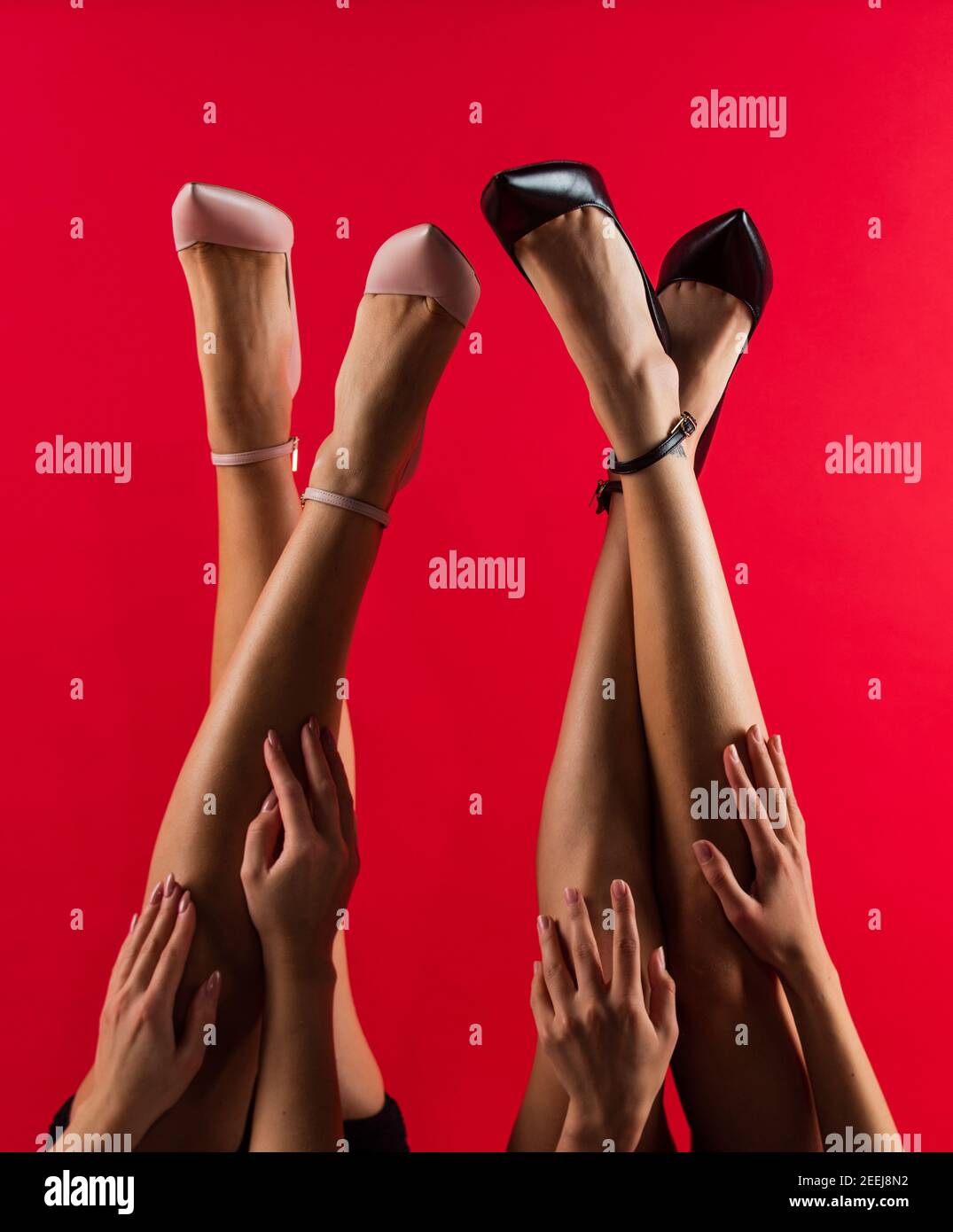Ladies, get ready to walk tall! This comprehensive guide explores the world of high heels, their impact on your feet, and how you can enjoy their stylish appeal without sacrificing your comfort and long-term foot health.
The Allure and Agony of Heels
High heels. They can make you feel powerful, stylish, and perhaps even a little taller. But they can also lead to discomfort and potential long-term foot problems. This guide will help you understand the effects of high heels on your feet, offering tips to strike a balance between style, comfort, and health. [https://chaztin.com/high-heels-feet]
The Downsides of High Heels: Potential Foot Problems
Wearing high heels significantly alters your foot posture, shifting your weight forward and increasing pressure on the balls of your feet. This can likely lead to a variety of issues:
- Pain and Discomfort: Concentrated pressure can cause aching, burning sensations, and general discomfort in the ball of your foot, especially with extended wear.
- Blisters and Calluses: Friction between your skin and the shoe may result in blisters and calluses on pressure points.
- Toe Troubles: High heels often compress toes, potentially causing bunions (a painful bony bump at the base of the big toe) or hammertoes (bent and curled toes).
- Aggravating Existing Conditions: If you have plantar fasciitis (heel and arch pain) or Achilles tendinitis, high heels may probably exacerbate the pain.
- Increased Risk of Falls: High heels can destabilize your balance, increasing the risk of ankle sprains and falls.
Choosing High Heels That Prioritize Foot Health
Finding stylish heels that are also kind to your feet is achievable. Consider these factors:
- Heel Height: Lower heels (2 inches or less) are generally recommended. Even a small decrease in height can significantly reduce pressure on the forefoot.
- Toe Box: Opt for a wide toe box to allow your toes room to move, minimizing the risk of bunions and hammertoes.
- Heel Counter: A sturdy heel counter (the back of the shoe) provides essential support and prevents slippage.
- Materials: Soft, flexible materials like leather or suede can conform to your foot shape, reducing pressure points.
- Break-in Period: Gradually break in new high heels by wearing them for short periods around the house.
Minimizing Risks: Tips for Happy Feet
Protecting your feet is crucial, even with the right heels. Follow these tips:
| Tip | Explanation |
|---|---|
| Limit Wearing Time | Avoid daily high heel use to minimize the time your feet are in an unnatural position. |
| Take Breaks | Take frequent breaks to rest and stretch your feet when wearing heels for extended periods. |
| Stretch Regularly | Perform foot stretches (pointing and flexing toes, rolling a tennis ball under your arch, calf stretches) to alleviate tightness. |
| Strengthen Your Feet | Exercises like toe curls and marble pickups improve foot muscle strength and support. |
| Listen to Your Body | Rest and elevate your feet if they hurt; don’t ignore pain. |
| Consult a Podiatrist | See a podiatrist for persistent foot pain to diagnose and address potential issues. |
After a tooth extraction, proper aftercare is crucial. Our guide on the first night after tooth extraction provides valuable information on managing pain, preventing infection, and promoting restful sleep.
Ongoing research explores the long-term effects of high heels. While a link between prolonged high heel use and foot problems is suggested, individual experiences vary. Factors like foot structure and gait may increase susceptibility. By making informed footwear choices and following these tips, you can enjoy high heels while minimizing potential risks.
How Do High Heels Affect Your Feet? The Biomechanics of Height
High heels change how you walk, concentrating pressure on the balls of your feet and disrupting your foot’s natural rolling motion. This can tighten the Achilles tendon and calf muscles, affecting balance and gait. [https://chaztin.com/high-heels-feet]
Here’s a breakdown of common high-heel-related foot problems:
| Foot Problem | Description |
|---|---|
| Metatarsalgia | Burning pain in the ball of the foot. |
| Bunions | Bony bumps at the base of the big toe. |
| Hammertoes | Bent and curled toes. |
| Morton’s Neuroma | Thickened nerve between toes, causing pain and numbness. |
| Plantar Fasciitis | Inflammation of the tissue along the bottom of the foot. |
The impact of high heels isn’t limited to immediate discomfort. Long-term use may contribute to osteoarthritis in the feet and ankles, potentially reducing mobility. Some experts believe individual foot structure plays a significant role in susceptibility.
Tips for Protecting Your Feet:
- Moderation: Limit frequency and duration of high heel use.
- Wise Choices: Choose shoes with a wide toe box and good arch support.
- Stretching: Regularly stretch calf muscles, Achilles tendon, and foot muscles.
- Support: Use orthotics or insoles.
- Professional Help: Consult a podiatrist for persistent pain.
Research on high heels is ongoing. While high heels alter foot function and can lead to problems, the precise relationship between heel height, frequency of wear, and individual susceptibility is complex. Prioritizing foot health is key to mitigating risks. This information is for general knowledge and does not replace professional medical advice.
What is High Heel Syndrome? Decoding the Discomfort
“High heel syndrome” refers to the various foot and body aches and pains associated with frequent high heel use. While not a formal medical diagnosis, it highlights the potential cumulative effects of wearing heels. [https://chaztin.com/high-heels-feet]
High heels force your feet into an unnatural position, concentrating pressure on the balls of your feet. This can lead to a cascade of problems, ranging from pain and calluses to more serious issues like bunions and hammertoe.
The altered posture from high heels can also affect your knees and lower back, potentially increasing the risk of pain and soreness. Ongoing research investigates the possible psychological impact of high heels, including potential links to body image concerns.
Potential Problems from Frequent High Heel Use:
| Problem | Description |
|---|---|
| Ball of foot pain | Aching or burning sensation. |
| Corns and Calluses | Thickened skin. |
| Bunions | Bony bumps at the base of the big toe. |
| Hammertoe | Unnaturally curled toes. |
| Ankle Sprains | Increased risk due to instability. |
| Knee Pain | Potential strain from altered alignment. |
| Back Pain | Possible increased risk due to postural changes. |
The impact of high heels varies among individuals. Factors like foot structure, heel type, and frequency of wear all play a role. While some experience no issues, others may have problems even with occasional use. High heel syndrome is complex, and research is ongoing. Prioritizing foot health is important when making footwear choices.
Why Are High Heels Considered Attractive? Unveiling the Allure
The attractiveness of high heels is a complex interplay of evolutionary, psychological, and cultural factors. [https://chaztin.com/high-heels-feet]
Several theories attempt to explain their allure:
- Exaggerated Femininity: High heels lengthen legs and accentuate curves, amplifying traditional markers of femininity.
- Confidence Boost: The increased height and improved posture can boost confidence and project power, which can be attractive.
- Status and Power: Historically, heels have been associated with higher social classes, adding to their allure.
- Sensory Stimulation: The clicking sound of heels draws attention and adds a sensory dimension to their appeal.
- Cultural Influence: Fashion trends and media portrayals reinforce the association of high heels with glamour and desirability.
If you’re planning a nose piercing, our guide to heart nose rings offers advice on size, style, and material.
While these theories often focus on traditional femininity, high heels are appreciated by people of all genders and orientations. The reasons for wearing and admiring heels are diverse.
Research on the appeal of high heels is ongoing. Attraction is complex and influenced by many factors. The provided information offers insights into the multifaceted allure of high heels, shaped by biology, psychology, culture, and personal preference.
- Bento Box Trays Streamline Restaurant Meal Presentation and Transport - December 13, 2025
- Plastic Bento Boxes Face Scrutiny Over Sustainability Impacts - December 11, 2025
- Bento Tray Revolutionizes Organized Meal Transport and Presentation - December 10, 2025










